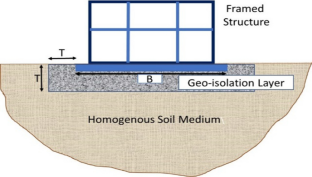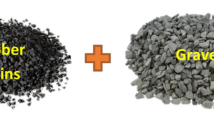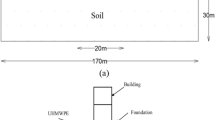Abstract
In the present study, a geotechnical seismic isolation (GSI) bed, composed of geosynthetic-reinforced sand–rubber tire shred mixture layer between the base of the building foundation and the supporting soil medium, is considered to mitigate ground vibrations. The index and engineering properties including dynamic properties of sand–rubber tire shred mixtures are carried out to assess their suitability for seismic base isolation of buildings. In addition to that, the liquefaction resistance of sand rubber mixtures is also evaluated. Further, laboratory-based model experiments and Finite Element (FE) modeling was carried out for footing resting on geogrid-reinforced GSI layer under static loading. Further, 2D seismic response of a typical building on GSI was also carried out using finite element code ABAQUS. Finally, results of a series of field experiments conducted to study the response of model footing resting on the geogrid-reinforced GSI bed subjected to horizontal ground vibration are presented. Further, a 3D finite element (FE) model of the field study was developed in the time-domain to simulate and investigate the response of geogrid-reinforced GSI bed on a multi-layered soil system for different surface wave characteristics. In general, it was found that GSI with geogrid reinforcement is found to be effective in the mitigation of ground vibrations due to earthquakes and other source of vibration.












































Similar content being viewed by others
References
Xiong W, Li Y (2013) Seismic isolation using granulated tire–soil mixtures for less-developed regions: experimental validation. Earthq Eng Struct Dyn 42:2187–2193. https://doi.org/10.1002/eqe.2315
Edil T, Bosscher P (1994) Engineering properties of tire chips and soil mixtures. Geotech Test J 17:453. https://doi.org/10.1520/GTJ10306J
Zornberg JG, Cabral AR, Viratjandr C (2004) Behaviour of tire shred & #150; sand mixtures. Can Geotech J 41:227–241. https://doi.org/10.1139/t03-086
Rao GV, Dutta RK (2006) Compressibility and strength behaviour of sand-tyre chip mixtures. Geotech Geol Eng 24:711–724. https://doi.org/10.1007/s10706-004-4006-x
Lee JH, Salgado R, Bernal A, Lovell CW (1999) Shredded tires and rubber-sand as lightweight backfill. J Geotech Geoenviron Eng 125:132–141
Mashiri MS, Vinod JS, Sheikh MN, Tsang H (2015) Shear strength and dilatancy behaviour of sand – tyre chip mixtures. Soils Found 55:517–528. https://doi.org/10.1016/j.sandf.2015.04.004
Cabalar AF (2011) Direct shear tests on waste tires – sand mixtures. Geotech Geol Eng 29:411–418. https://doi.org/10.1007/s10706-010-9386-5
Ghazavi M, Lavasan AA (2008) Interference effect of shallow foundations constructed on sand reinforced with geosynthetics. Geotext Geomembranes 26:404–415. https://doi.org/10.1016/j.geotexmem.2008.02.003
Anbazhagan P, Manohar DR, Rohit D (2017) Influence of size of granulated rubber and tyre chips on the shear strength characteristics of sand–rubber mix. Geomech Geoengin 12:266–278. https://doi.org/10.1080/17486025.2016.1222454
Edincliler A, Cabalar AF, Cevik A, Isik H (2018) New formulations for dynamic behavior of sand-waste tire mixtures in a small range of strain amplitudes. Period Polytech Civ Eng 62:92–101. https://doi.org/10.3311/PPci.8698
Lee JH, Salgado R, Bernal A, Lovell CW (1999) Shredded tires and rubber-sand as lightweight backfill. J Geotech Geoenvironmental Eng 125:132–141. https://doi.org/10.1061/(asce)1090-0241(1999)125:2(132)
Bergado DT, Youwai S, Rittirong A (2005) Strength and deformation characteristics of flat and cubical rubber tyre chip–sand mixtures. Géotechnique 55:603–606. https://doi.org/10.1680/geot.2005.55.8.603
Mashiri MS, Vinod JS, Sheikh MN, Tsang HH (2015) Shear strength and dilatancy behaviour of sand-tyre chip mixtures. Soils Found 55:517–528. https://doi.org/10.1016/j.sandf.2015.04.004
Senetakis K, Anastasiadis A (2015) Effects of state of test sample, specimen geometry and sample preparation on dynamic properties of rubber–sand mixtures. Geosynth Int 22:301–310. https://doi.org/10.1680/gein.15.00013
Nakhaei A, Marandi SM, Sani Kermani S, Bagheripour MH (2012) Dynamic properties of granular soils mixed with granulated rubber. Soil Dyn Earthq Eng 43:124–132. https://doi.org/10.1016/j.soildyn.2012.07.026
Ehsani M, Shariatmadari N, Mirhosseini SM (2015) Shear modulus and damping ratio of sand-granulated rubber mixtures. J Cent South Univ 22:3159–3167. https://doi.org/10.1007/s11771-015-2853-7
Li B, Huang M, Zeng X (2016) Dynamic behavior and liquefaction analysis of recycled-rubber sand mixtures. J Mater Civ Eng 28:04016122. https://doi.org/10.1061/(ASCE)MT.1943-5533.0001629
Feng ZY, Sutter KG (2000) Dynamic properties of granulated rubber/sand mixtures. Geotech Test J 23:338–344. https://doi.org/10.1520/GTJ11055J
Anastasiadis A, Senetakis K (2012) Small-strain shear modulus and damping ratio of sand-rubber and gravel-rubber mixtures. Geotech Geol Eng 30:363–382. https://doi.org/10.1007/s10706-011-9473-2
Mashiri MS, Vinod JS, Sheikh MN (2016) Constitutive model for sand-tire chip mixture. Int J Geomech 16:1–10. https://doi.org/10.1061/(ASCE)GM.1943-5622.0000472
Tsang H-H, Lo SH, Xu X, Neaz Sheikh M (2012) Seismic isolation for low-to-medium-rise buildings using granulated rubber–soil mixtures: numerical study. Earthq Eng Struct Dyn Struct Dyn 41:2009–2024. https://doi.org/10.1002/eqe.2171
Pitilakis K, Karapetrou S, Tsagdi K (2015) Numerical investigation of the seismic response of RC buildings on soil replaced with rubber-sand mixtures. Soil Dyn Earthq Eng 79:237–252. https://doi.org/10.1016/j.soildyn.2015.09.018
Dasgupta B, Beskos DE, Vardoulakis IG (1990) Vibration isolation using open or filled trenches Part 2: 3-D homogeneous soil. Comput Mech 6:129–142. https://doi.org/10.1007/BF00350518
Woods RD, Arbor A (2017) Effect of pile-driving induced vibrations on nearby structures and other assets effect of pile-driving induced vibrations on nearby structures and other assets final report submitted to ORBP Number OR10–046 by Athena Grizi (Graduate Research Assistant). https://doi.org/10.13140/RG.2.2.11750.73282
Al-Hussaini TM, Ahmad S (1991) Design of wave barriers for reduction of horizontal ground vibration. J Geotech Eng 117:616–636. https://doi.org/10.1061/(ASCE)0733-9410(1991)117:4(616)
Çelebi E, Firat S, Beyhan G et al (2009) Field experiments on wave propagation and vibration isolation by using wave barriers. Soil Dyn Earthq Eng 29:824–833. https://doi.org/10.1016/j.soildyn.2008.08.007
Gao G, Li N, Gu X (2015) Field experiment and numerical study on active vibration isolation by horizontal blocks in layered ground under vertical loading. Soil Dyn Earthq Eng 69:251–261. https://doi.org/10.1016/j.soildyn.2014.11.006
Liyanapathirana DS, Ekanayake SD (2016) Application of EPS geofoam in attenuating ground vibrations during vibratory pile driving. Geotext Geomembranes 44:59–69. https://doi.org/10.1016/j.geotexmem.2015.06.007
Bose T, Choudhury D, Sprengel J, Ziegler M (2018) Efficiency of open and infill trenches in mitigating ground-borne vibrations. J Geotech Geoenvironmental Eng 144:04018048. https://doi.org/10.1061/(asce)gt.1943-5606.0001915
Goktepe F, Sahin M, Celebi E (2020) Small shaking table testing and numerical analysis of free-field site response and soil-structure oscillation under seismic loading. Bull Eng Geol Environ 79:2949–2969. https://doi.org/10.1007/s10064-020-01742-w
Christopoulos C, Filiatrault A (2006) Principle of passive supplemental damping and seismic isolation
Kelly JM (2002) Seismic isolation systems for developing countries. Earthq Spectra 18:385–406
Booth ED, Key D (2006) Earthquake design practice for buildings. Thomas Telford
Mayes RL, Naeim F (1997) Seismic design handbook. Springer
Naeim F, Kelly JM (1999) Design of Seismic Isolated Structures. Wiley, Hoboken
Novak M, Henderson P (1989) Base-isolated buildings with soil-structure interaction. Earthq Eng Struct Dyn 18:751–765
Ealangi I (2010) Earthquake protection of buildings by seismic isolation. Devices and concepts isolation. Devices and concepts. Young res Conf
Skinner R, McVerry WH, Robinson GH (1994) An introduction to sekmic isolation. Struct Saf 14:219–224. https://doi.org/10.1177/1757913910379198
Roeder CW, Stanton JF, Taylor AW (1990) Fatigue of steel-reinforced elastomeric bearings. J Struct Eng 116:407–426. https://doi.org/10.1061/(asce)0733-9445(1990)116:2(407)
Thompson DJ, Jiang J, Toward MGR et al (2015) Mitigation of railway-induced vibration by using subgrade stiffening. Soil Dyn Earthq Eng 79:89–103
Jalali A, Cardone D, Narjabadifam P (2011) Smart restorable sliding base isolation system. Bull Earthq Eng 9:657–673. https://doi.org/10.1007/s10518-010-9213-7
Krishnamoorthy A, Anita S (2016) Soil–structure interaction analysis of a FPS-isolated structure using finite element model. Structures 5:44–57. https://doi.org/10.1016/j.istruc.2015.08.003
Dolce M, Cardone D, Palermo G (2007) Seismic isolation of bridges using isolation systems based on flat sliding bearings. Bull Earthq Eng 5:491–509. https://doi.org/10.1007/s10518-007-9044-3
Necdet T (2004) Seismic Isolation and Energy Dissipating Systems. 1–13
Xiao H, Butterworth JW, Larkin T (2004) Low-technology techniques for seismic isolation. In: 2004 NZSEE Conference. 36
Hazarika H, Yasuhara K, Kikuchi Y et al (2010) Multifaceted potentials of tire-derived three dimensional geosynthetics in geotechnical applications and their evaluation. Geotext Geomembranes 28:303–315. https://doi.org/10.1016/j.geotexmem.2009.10.011
Kaneko T, Orense RP, Hyodo M, Yoshimoto N (2013) Seismic response characteristics of saturated sand deposits mixed with tire chips. J Geotech Geoenvironmental Eng 139:633–643. https://doi.org/10.1061/(ASCE)GT.1943-5606.0000752
Tsang H (2008) Seismic isolation by rubber–soil mixtures for developing countries. Earthq Eng Struct Dyn 37:283–303
Yegian MK, Kadakal U, Catan M (1999) Geosynthetics for Earthquake Hazard Mitigation. Geosynth ’99 Specif Geosynth Dev Des Details
Bandyopadhyay S, Sengupta A, Reddy GR (2015) Performance of sand and shredded rubber tire mixture as a natural base isolator for earthquake protection. Earthq Eng Eng Vib 14:683–693. https://doi.org/10.1007/s11803-015-0053-y
Anastasiadis A, Senetakis K, Pitilakis K (2012) Small-strain shear modulus and damping ratio of sand-rubber and gravel-rubber mixtures. Geotech Geol Eng 30:363–382. https://doi.org/10.1007/s10706-011-9473-2
Senetakis K, Anastasiadis A (2015) Effects of state of test sample, specimen geometry and sample preparation on dynamic properties of rubber – sand mixtures
Hazarika H, Kohama E, Sugano T (2008) Underwater shake table tests on waterfront structures protected with tire chips cushion. J Geotech Geoenvironmental Eng 134:1706–1719. https://doi.org/10.1061/(ASCE)1090-0241(2008)134:12(1706)
Lade PV (2016) Triaxial testing of soils. John Wiley, Hoboken
Tabrizi MK, Abrishami S, Hosseininia ES et al (2019) Experimental investigation on the behavior of fine-grained soils containing waste rubber tires under repeated and static loading using direct shear apparatus. Constr Build Mater 223:106–119
Lee HJ, Roh HS (2007) The use of recycled tire chips to minimize dynamic earth pressure during compaction of backfill. Constr Build Mater 21:1016–1026. https://doi.org/10.1016/j.conbuildmat.2006.02.003
Reddy SB, Krishna AM (2021) Sand–scrap tyre chip mixtures for improving the dynamic behaviour of retaining walls. Int J Geotech Eng 15:1093–1105. https://doi.org/10.1080/19386362.2019.1652969
Madhusudhan BR, Boominathan A, Banerjee S (2021) Engineering properties of sand–rubber tire shred mixtures. Int J Geotech Eng 15:1061–1077. https://doi.org/10.1080/19386362.2019.1617479
Anvari SM, Shooshpasha I, Kutanaei SS (2017) Effect of granulated rubber on shear strength of fine-grained sand. J Rock Mech Geotech Eng 9:936–944. https://doi.org/10.1016/j.jrmge.2017.03.008
Manohar DR, Anbazhagan P, Sheikh MN, Tsang HH (2014) Effects of geosynthetic reinforcement on the mechanical behaviour of composite materials for vibration isolation. In: Proceedings of the 23rd Australasian Conference on the Mechanics of Structures and Materials, Byron Bay, Australia (pp. 217-222).
Madhusudhan BR, Boominathan A, Banerjee S (2019) Factors affecting strength and stiffness of dry sand-rubber tire shred mixtures. Geotech Geol Eng 37:2763–2780. https://doi.org/10.1007/s10706-018-00792-y
Madhusudhan BR, Boominathan A, Banerjee S (2017) Static and large-strain dynamic properties of sand-rubber tire shred mixtures. J Mater Civ Eng 29:1–7. https://doi.org/10.1061/(asce)mt.1943-5533.0002016
Watanabe K, Kusakabe O (2013) Reappraisal of loading rate effects on sand behavior in view of seismic design for pile foundation. Soils Found 53:215–231
Ladd RS (1978) Preparing test specimens using undercompaction. Geotech Test J 1:16–23. https://doi.org/10.1520/GTJ10364J
Senthen Amuthan M, Boominathan A, Banerjee S (2018) Density and shear strength of particulate rubber mixed with sand and fly ash. J Mater Civ Eng 30:04018136. https://doi.org/10.1061/(asce)mt.1943-5533.0002322
Bosscher PJ, Edil TB, Eldin NN (1992) Construction and performance of a shredded waste tire test embankment. Transp Res Rec.
Senthen Amuthan M, Boominathan A, Banerjee S (2021) Sand and concrete interface behaviour of particulate rubber -sand - fly ash mixture. Int J of Geotech Eng 15(6):753–759. https://doi.org/10.1080/19386362.2018.1499269
Senthen Amuthan M, Boominathan A, Banerjee S (2020) Undrained cyclic responses of granulated rubber-sand mixtures. Soils Found 60:871–885. https://doi.org/10.1016/j.sandf.2020.06.007
Pasha SMK, Hazarika H, Yoshimoto N (2019) Physical and mechanical properties of gravel-tire chips mixture (GTCM). Geosynth Int 26:92–110. https://doi.org/10.1680/jgein.18.00041
Hazarika H, Yasuhara K, Kikuchi Y et al (2010) Investigation of tire chips-sand mixtures as preventive measure against liquefaction geotextiles and geomembranes multifaceted potentials of tire-derived three dimensional geosynthetics in geotechnical applications and their evaluation. Geotext Geomembranes 28:303–315. https://doi.org/10.1016/j.geotexmem.2009.10.011
IS 1498 (1970) Classification and identification of soils for general engineering purposes. Bureau of Indian Standards (BIS), New Delhi
ASTM International (2001) Standatd test method for determining tensile properties of geogrid by single and multi-rib tensile method. ASTM 6631–01, West Conshohocken, PA: ASTM.
Dhanya JS, Boominathan A, Banerjee S (2019) Performance of geo-base isolation system with geogrid reinforcement. Int J Geomech 19:04019073. https://doi.org/10.1061/(asce)gm.1943-5622.0001469
Wood DM (2004) Geotechnical Modelling. Taylor & Francis, Abingdon
Hegde A, Sitharam TG (2013) Experimental and numerical studies on footings supported on geocell reinforced sand and clay beds. Int J Geotech Eng 7:346–354. https://doi.org/10.1179/1938636213Z.00000000043
Viswanadham BVS, König D (2004) Studies on scaling and instrumentation of a geogrid. Geotext Geomembranes 22:307–328. https://doi.org/10.1016/S0266-1144(03)00045-1
Madhavi Latha G, Somwanshi A (2009) Effect of reinforcement form on the bearing capacity of square footings on sand. Geotext Geomembranes 27:409–422. https://doi.org/10.1016/j.geotexmem.2009.03.005
Yetimoglu T, Wu JTH, Saglamer A (1994) Bearing capacity of rectangular footings on geogrid-reinforced sand. J Geotech Eng 120:2083–2099. https://doi.org/10.1061/(ASCE)0733-9410(1996)122:4(326)
Binquit J, Lee KL (1975) Bearing capacity tests on reinforced earth slabs. J Geotech Eng Div 101(12):1241–1255
Alejano LR, Bobet A (2012) Drucker-Prager criterion. Rock Mech Rock Eng 45:995–999. https://doi.org/10.1007/s00603-012-0278-2
Dhanya JS, Boominathan A, Banerjee S (2020) Response of low-rise building with geotechnical seismic isolation system. Soil Dyn Earthq Eng 136:106187. https://doi.org/10.1016/j.soildyn.2020.106187
Raghukanth STG, Kavitha B (2014) Ground motion relations for activeregions in India. Pure Appl Geophys 171:2241–2275. https://doi.org/10.1007/s00024-014-0807-x
IS 1893 Part I (2016) Criteria for earthquake resistant design of structures: general provisions and buildings- Code of Practice. Bureau of Indian Standards, New Delhi
Kirar B, Maheshwari BK, Muley P (2016) Correlation between shear wave velocity (Vs) and SPT resistance (N) for Roorkee region. Int J Geosynth Gr Eng 2:1–11. https://doi.org/10.1007/s40891-016-0047-5
NBC (2016) National building code of India. Bureau of Indian Standards (BIS), New Delhi
Bowles JE (2001) Foundation analysis and design. The McGraw-Hill Companies, Inc. 5th Edition, New York, USA
IS 456 (2016) Plain and reinforced concrete-code of practice. Bureau of Indian Standards, New Delhi
CSI (2010) SAP2000 V14 Analysis Manual: Inelastic Time History Analysis. CSI (Computers and Structures Inc.), Berkley, USA
Corotis RB, Farzin MH, Krizeck RJ (1974) Nonlinear stress-strain formulations for soil. J Geotech Eng Div 100:993–1008
Ishibashi I (1992) Discussion, effect of soil plasticity on cyclic response. J Geotech Eng 118:830–832. https://doi.org/10.1061/(ASCE)0733-9410(1992)118:5(829.2)
Van NQ, Fatahi B, Hokmabadi AS (2017) Influence of size and load-bearing mechanism of piles on seismic performance of buildings considering soil-pile-structure interaction. Int J Geomech 17:1–22. https://doi.org/10.1061/(ASCE)GM.1943-5622.0000869
Wolf JP, Song C (1996) Finite-element modelling of unbounded media. John Wiley & Sons, West Sussex
Xu R, Fatahi B (2018) Geosynthetic-reinforced cushioned piles with controlled rocking for seismic safeguarding. Geosynth Int 25:561–581. https://doi.org/10.1680/jgein.18.00018
IS 1904 (1986) Code of practice for design and construction of foundations in soils: general requirements. Third Revision. Bureau of Indian Standards, New Delhi
Richart JFE, Hall JR Jr, Woods RD (1970) Vibrations of soils and foundations. Prentice Hall, Englewood Cliffs
Woods D (1968) Screening of surface waves in soils. J Soil Mech Found Div 94:951–979. https://doi.org/10.1061/JSFEAQ.0001180
Dhanya JS, Boominathan A, Banerjee S (2022) Investigation of geotechnical seismic isolation bed in horizontal vibration mitigation. J Geotech Geoenvironmental Eng 148:1–17. https://doi.org/10.1061/(asce)gt.1943-5606.0002917
Miglani VD (1991) An estimation of dynamic properties of soils from block vibration tests. In: second international conference on recent advances in geotechnical earthquake engineering and soil dynamics. St. Louis, Missouri, pp 183–190
Dhanya JS, Boominathan A, Banerjee S (2017) Response of soil-tyre mixture subjected to cyclic loading. In: 16th World Conference on Earthquake Engineering (WCEE 2017), Resilience – The New Challenge in Earthquake Engineering. Santiago, Chili, pp 8479–8489
ASTM D-6637 (2001) Standard test method for determining tensile properties of geogrids by the single or multi-rib tensile method. ASTM International, West Conshohocken, PA
Cresswell A, Barton M, Brown R (1999) Determining the maximum density of sands by pluviation. Geotech Test J 22:324–328. https://doi.org/10.1520/GTJ11245J
Boominathan S, Senathipathi K, Jayaprakasam V (1991) Field studies on dynamic properties of reinforced earth. Soil Dyn Earthq Eng 10:402–406. https://doi.org/10.1016/0267-7261(91)90054-4
Sreedhar MVS, Abhishek J (2016) Effect of geosynthetic reinforcement on dynamic characteristics through model block. In: Indian Geotechnical Conference IGC2016. pp 15–18
Venkateswarlu H, Ujjawal KN, Hegde A (2018) Laboratory and numerical investigation of machine foundations reinforced with geogrids and geocells. Geotext Geomembranes 46:882–896. https://doi.org/10.1016/j.geotexmem.2018.08.006
Gelagoti F, Kourkoulis R, Anastasopoulos I, Gazetas G (2012) Rocking isolation of low-rise frame structures founded on isolated footings. Earthq Eng Struct Dyn 41:1177–1197. https://doi.org/10.1002/eqe.1182
Aung AMW, Leong EC (2012) Finite-element modeling of continuous surface waves tests: numerical accuracy with respect to domain size. J Geotech Geoenvironmental Eng 137:1294–1298. https://doi.org/10.1061/(ASCE)GT.1943-5606.0000545
Courant R, Friedrichs K, Lewy H (1967) On the partial difference equations of mathematical physics. IBM J Res Dev 11:215–234
Alzawi A, El Naggar MH (2011) Full scale experimental study on vibration scattering using open and in-filled (GeoFoam) wave barriers. Soil Dyn Earthq Eng 31:306–317. https://doi.org/10.1016/j.soildyn.2010.08.010
Acknowledgements
The author extends warm gratitude to Prof. Subhadeep Banerjee, Indian Institute of Technology Madras, who played an active role in the above project team and significantly contributed to its successful completion. Dr. J.S. Dhanya, Eurasian National University, deserves special recognition for her valuable contributions to the study and her assistance in preparing and formatting the paper. The untiring and intense efforts of all my Ph.D. students, particularly Dr. B.R. Madhusudhan and Mr. Senthen Amuthan, contributing to the above research in Soil Dynamics and Earthquake Geotechnical Engineering are deeply appreciated. Er. I.V. Anirudhan from M/s. Geotechnical Solutions of Chennai provided invaluable inputs for the preparation of this paper. Gratitude is also expressed toward the funding agencies, with a special mention to the Ministry of Earth Sciences, Government of India, for their financial support through the project funding MoES/P.O.(Seismo)/1(248)/2014]. The Tamil Nadu Slum Clearance Board played a vital role in facilitating the field test program at their construction site. Technical assistance provided by Mr. Murali, Mr. Aravind Raj, and Mr. Ganesh, the technical staff of IIT Madras during the field testing phase, is greatly acknowledged. The author extends heartfelt gratitude to IGS National body and the selection committee members for their valuable decision in selecting me to deliver the IGS annual lecture in 2022. Gratitude is also extended to the IGS Kochi Chapter for their efforts in producing and distributing the lecture in booklet form to the delegates of the IGC 2022 conference.
Author information
Authors and Affiliations
Corresponding author
Ethics declarations
Conflict of interest
The author declared that there is no conflict of interest in this work.
Additional information
Publisher's Note
Springer Nature remains neutral with regard to jurisdictional claims in published maps and institutional affiliations.
Rights and permissions
Springer Nature or its licensor (e.g. a society or other partner) holds exclusive rights to this article under a publishing agreement with the author(s) or other rightsholder(s); author self-archiving of the accepted manuscript version of this article is solely governed by the terms of such publishing agreement and applicable law.
About this article
Cite this article
Boominathan, A. Innovative Geotechnical Solutions for Base Isolation of Buildings. Indian Geotech J 54, 3–39 (2024). https://doi.org/10.1007/s40098-023-00771-y
Received:
Accepted:
Published:
Issue Date:
DOI: https://doi.org/10.1007/s40098-023-00771-y




